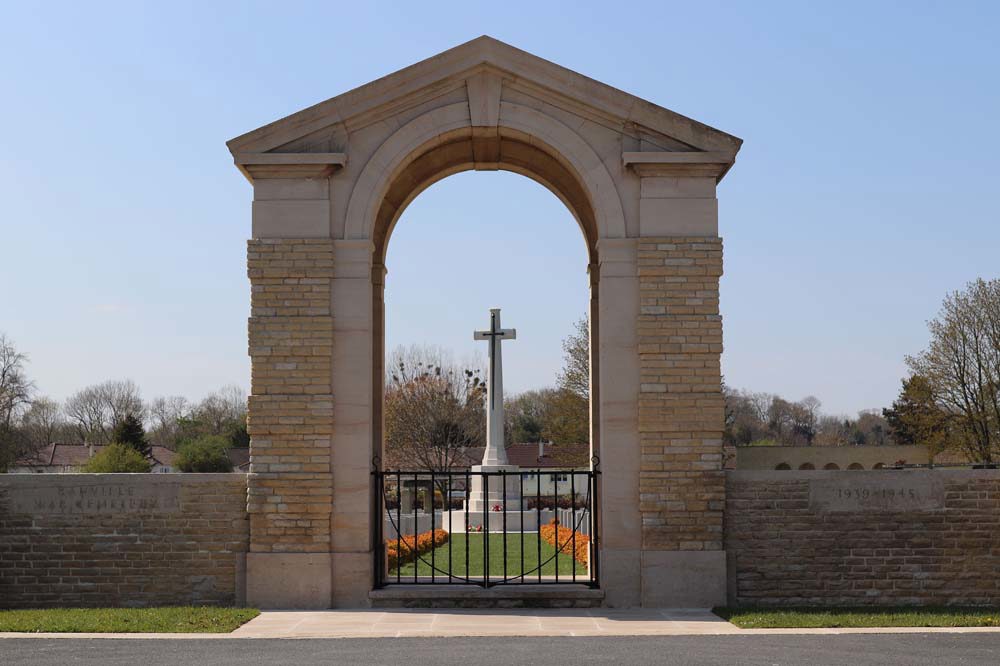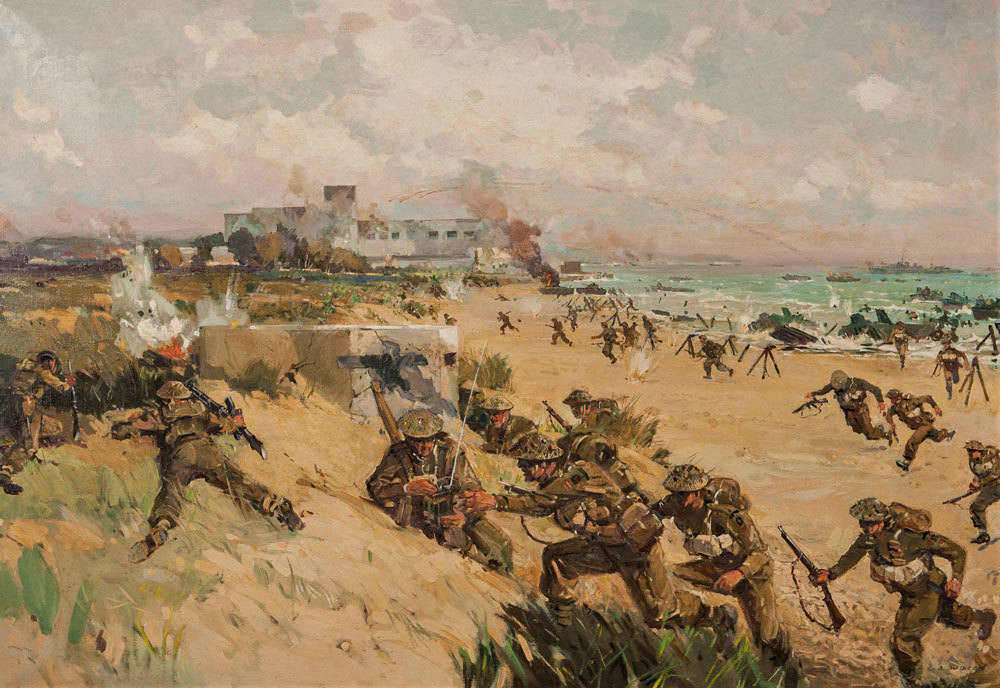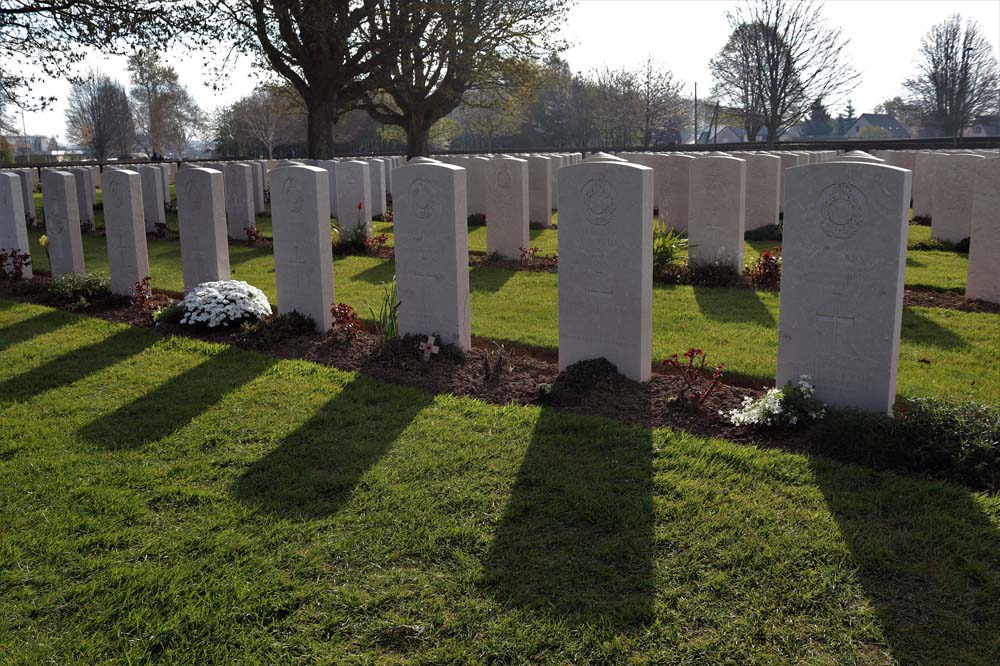06 June 2023
The D-Day story told in Commonwealth War Graves cemeteries & memorials
June 6th marks the anniversary of the D-Day landings and Operation Overlord. Did you know CWGC commemorates the fallen of this momentous battle in our D-Day war graves, cemeteries & memorials?
D-Day
Operation Overlord
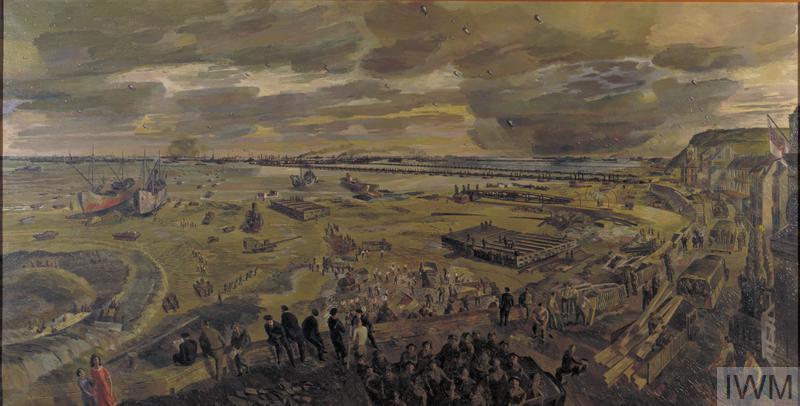
The Landings at Arromanche, Barnett Freedman, 1947 (© IWM Art.IWM ART LD 5816)
Operation Overlord refers to the Allied amphibious invasion of Normandy which took place on June 6th 1944.
On the morning of June 6th, thousands of Allied soldiers stormed five Normandy beaches to launch the campaign that led to the liberation of Western Europe in WW2 from Nazi oppressors.
This was a truly international effort, with troops from the UK, Canada and the United States leading the assault. They were supported by service personnel from Australia, Belgium, Czechoslovakia, The Netherlands, Free France, Greece, New Zealand, Norway, Rhodesia, and Poland.
They fought on land, air, and sea with all three major services coordinating their efforts to ensure the landings were a success. Thousands of ships, aircraft, and tens of thousands of men were involved.
Five beaches, Juno, Sword, Gold, Utah, and Omaha were stormed, but not after tens of thousands of British and American paratroopers were dropped behind enemy lines to disable strongpoints and capture important bridges.
Operation Overlord remains the largest operation of its type in history and one of the most important campaigns of World War II.
Over 156,000 soldiers had landed in France by the end of D-Day. Two million more would follow in the coming months, on their way to liberate France, Belgium, and Europe.
Normandy Landings stats
- 7,000 Allied ships & landing craft
- 12,000 Allied aircraft
- 156,000 men
- 75,215 British & Canadian troops landed on Gold, Sword & Juno beaches
- 57,500 American troops landed on Utah & Omaha beaches
- 20,000 Airborne soldiers landed
- 4,400 killed or missing
Casualties of D-Day
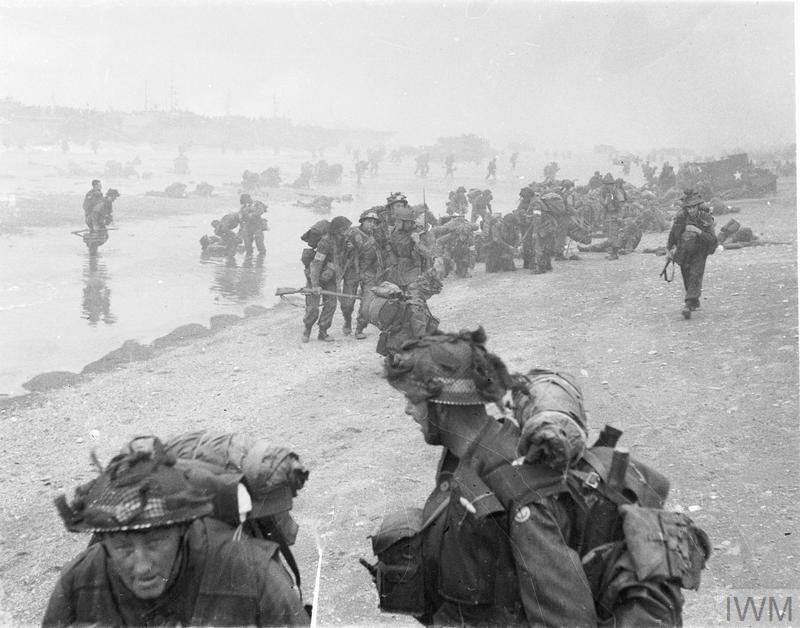
8.45 am Sword Beach, 6 June 1944 (© IWM)
As with all major WW2 operations the Normandy Landings incurred casualties and, tragically, deaths of soldiers young and old.
Overall, it’s estimated around 4,400 men were killed or went missing on D-Day. Spotless record-keeping was not possible at the time, but various research bodies and institutions have come up with the figure quoted above.
The Canadian units landing on Juno Beach are estimated to have taken over 1,000 total casualties. CWGC commemorate 370 Canadian soldiers who lost their lives on D-Day and are commemorated in France.
As for the British, landing on Sword and Gold Beach or dropping in by glider or parachute as airborne troops, the casualties were higher. We commemorate just over 1,220 British servicemen who died on D-Day.
While CWGC does not commemorate American soldiers, it is worth mentioning their sacrifice. First US Army records for the Normandy Landings suggest around 2,500 US troops were killed or went missing on June 6th 1944.
D-DAY GRAVES AND cemeteries
The war cemeteries and memorials maintained by Commonwealth War Graves in Normandy tell the story of D-Day in casualties and headstones.
Ranville War Cemetery
Some 2,400 Second World War Commonwealth casualties’ eternal resting place lies at Ranville War Cemetery in Normandy. 220 of the men buried there are casualties of D-Day.
As you approach the cemetery, you’ll notice how designer Phillip Hepworth, delicately framed Ranville’s Cross of Sacrifice through the entryway’s elegant arch. Step in and row upon row of CWGC headstones await, each marking the grave of a WW2 soldier.
Ranville saw some of the earliest action on D-Day. British glider pilots and paratroopers courageously landed near the village at 00.16 on the morning of June 6th.
Their mission was to capture and hold two vital river crossings over the Orne River and Caen Canal. One such crossing, Pegasus Bridge, has gone down in legend as one of the most audacious airborne drops ever.
The men of the Oxford and Buckinghamshire Light Infantry claimed their objectives, but this came at a cost. At the back of Ranville War Cemetery, there are rows and rows of paratroopers and glider pilots that gave their lives to take these important objectives.
Private Emile Corteil
 Image: Private Corteil and his canine companion Glen
Image: Private Corteil and his canine companion Glen
Private Emile Corteil was just 19 years old when he parachuted into Normandy on D-Day. His unit, the 9th (Essex) Parachute Battalion was tasked with destroying the Merville Battery: a heavily defended German gun position trained on Sword Beach.
As well as his fellow paratroopers, Emile was dropped into France with another companion: Glen his para-dog. These airborne canines were trained to sniff out explosives and could help spot enemy positions and potential booby traps.
While Emile and Glen landed successfully, the pair were, unfortunately, both killed in action later the 6th. Today, Emile is buried in Ranville War Cemetery after his grave was moved from a temporary location in Gonneville-sur-Melville.
It’s believed that Glen was buried alongside his master.
Beny-Sur-Mer Canadian War Cemetery
The Canadian Army was integral to the success of the D-Day Landings.
Their landing beach, Juno, was heavily defended and Canadian units, including the Royal Winnipeg Rifles, Regina Rifles, Queen’s Own Rifles of Canada, and the North Shore (New Brunswick) Regiment, took heavy casualties as they crossed Juno’s sands.
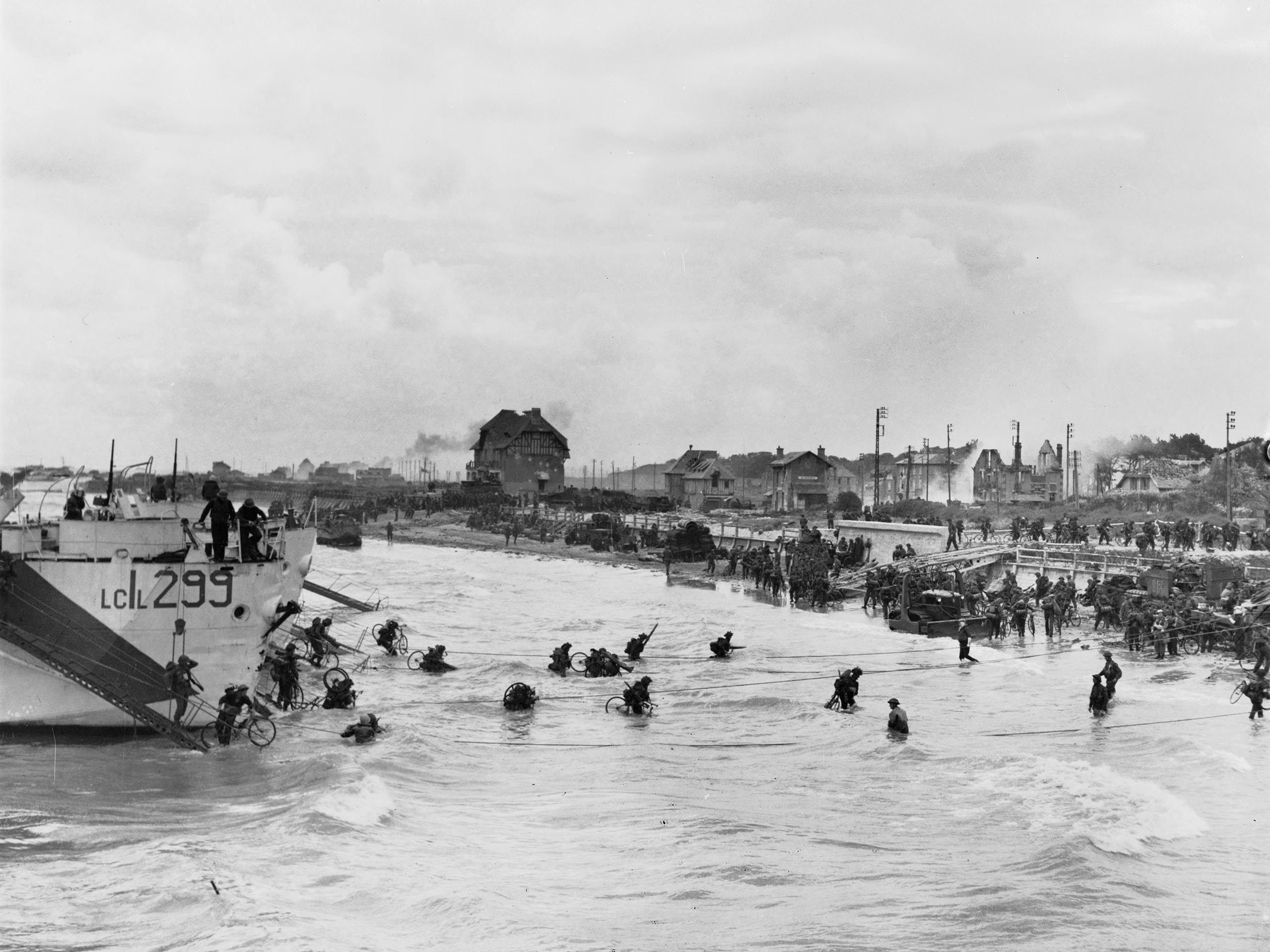
Canadian troops pour ashore, Juno Beach, 6 June 1944 (© IWM)
In a testament to the dogged determination and sheer naked courage that came to characterise the Canadians during World War Two, Juno was taken. In fact, by the end of the first day of Operation Overlord, the Canadians had advanced further than any other Allied formation.
Nearly all of Canada’s D-Day war dead are buried in the peaceful surroundings of Beny-Sur-Mer Canadian War Cemetery.
The cemetery holds 2,000 Canadian burials of the second world war with several hundred being casualties of D-Day.
The cemetery is not far from Juno Beach but offers a stark counterpoint to the carnage experienced by so many throughout the Normandy Landings.
Maple trees dot the cemetery grounds, but the species’ iconic leaves don’t just sit on their branches: they can be found inscribed on the headstones of the Canadian soldiers buried here.
Chaplain Walter Brown
 Image: Chaplain Walter Brown, presumed murdered by the SS on D-Day
Image: Chaplain Walter Brown, presumed murdered by the SS on D-Day
The spiritual needs of soldiers across the Commonwealth were catered to by army chaplains and padres during World War Two.
Anglican Minister Walter Brown volunteered to join the war effort in 1941, joining the Canadian Chaplain Service in 1941.
Walter was assigned to the Sherbrooke Fusiliers Regiment. He was one of the first chaplains to reach Normandy.
When the Sherbrookes were forging inland, Walter was there with them. One of his roles was to help carry wounded soldiers from the frontline back to aid stations. While undertaking such a mission, Walter was captured by soldiers of the 12th SS Panzer Division.
The SS already had a ruthless reputation and were merciless in the treatment of their captives. It is believed Walter fell victim to the SS. His body was found later in June as the Canadians pushed up to the village of Deny-sur-Mer, murdered by his captors.
Walter was laid to rest in Beny-Sur-Mer along with his countrymen who died on D-Day and throughout the rest of the Normandy Campaign.
Hermanville War Cemetery
Hermanville-Sur-Mer today is a quiet, pleasant French village, lying just one kilometre from the region’s sandy beaches.
79 years ago, it wasn’t quite so peaceful. Hermanville-Sur-Mer sat in the path of the advancing Allied invasion force, falling into the path of Sword Beach and the advancing British 3rd Infantry Division.
Sword Beach was the most easterly of the D-Day landing zones. The 1st South Lancashire and 2nd East Yorkshire battalions formed the spear tip, with the first soldiers wading ashore at 7.25 am.

The assault on Sword Beach, 6 June 1944 (© IWM)
Military operations planners forecast a terrible time for the South Lancs and East Yorkshires. Estimates suggested the two battalions were expected to suffer 70% casualties.
Fortunately, casualties were much lighter than expected. German military resistance was determined but eventually, the 3rd Division was able to break through and push onto the Normandy mainland. The 3rd Division took 630 killed, wounded, or missing on D-Day.
By the end of June 6th, 29,000 British troops landed on Sword Beach.
Hermanville was taken by the 1st South Lancs on D-Day itself. The soldiers were still covered in sand when they hit and took the village from its Wehrmacht occupiers.
Today, Hermanville War Cemetery marks the final resting place of around 1,000 servicemen of World War Two. Many of those who fell during the Sword landings, and the drive inland, are buried at Hermanville.
Outside the cemetery, you may notice a large red triangle adorns the floor of the entranceway. The red triangle was the symbol of the British 3rd Division, men of which are today resting eternally inside Hermanville War Cemetery.
Philip Hepworth, architect and designer of Hermanville, chose to replicate the path the advancing infantry took in the look and feel of the cemetery. Grassy dunes give way to lush greenery, reflecting the transition from beach outskirts to Normandy countryside.
While some trees have been replanted, the cemetery will soon be a verdant green garden once more.
Major Robert Barber
 Image: Major Robert Barber, killed on D-Day
Image: Major Robert Barber, killed on D-Day
Career soldier Major Robert Barber was one of the first men to come ashore at Sword Beach.
Robert had been serving with the British Army for nearly a decade up to D-Day, first signing up in 1936.
Much of his military life prior to World War Two had been spent with the Nottinghamshire Regiment in India, but circumstances would soon bring Major Barber back to the UK and ultimately Europe.
Robert came ashore leading his men in the first waves to hit Sword Beach. He was struck down by the impact of an exploding mortar bomb and was killed instantly.
Such was the fate of many of the men of D-Day: all the training and preparation aided them greatly, but they were still susceptible to the risks and bad luck all battlefields represent.
Robert is buried alongside many of his comrades at Hermanville War Cemetery.
Ryes War Cemetery
Normandy in peacetime is a spot of pure bucolic splendour, replete with verdant country lanes, rolling hills, and lush countryside.
Ryes War Cemetery retains the characteristics of the Normandy countryside. It’s set in open country, providing a small oasis of calm amidst the bocage. It’s the final resting place of some 870 Commonwealth servicemen and over 270 German soldiers.
A pair of stone pergola flank the Cross of Sacrifice, creating two halves of the cemetery. Through spring and summer, Rye War Cemetery is alive with bright blooms, further integrating the cemetery with its countryside surroundings. A small cream stone shelter sits in the rear, providing a space for quiet contemplation.
Gold Beach, a British-designated landing zone, was the most westerly of the assault targets assigned to the Commonwealth armies.
It fell to the men of the 50th (Northumbrian) Infantry Division to take Gold. At 7.25 am, the landing craft hit the beach and out poured soldiers from the Hampshire, Dorset, East Yorkshire, and Yorkshire regiments, determined to capture their objectives and push inland.
The infantry was supported by amphibious tanks of the 8th Armoured Brigade. Together, man and machine were able to push onward and drive the German defenders back into Normandy.
The 50th Infantry Division sustained 400 casualties on D-Day itself. Particularly hard hit were the men of the 1st Hampshires.
As they crossed Gold Beach’s sand dunes, the Hampshires were immediately greeted by the punishing mortar and machine gun fire. 60 men were killed. Despite their losses, the Hampshires were able to complete their goals, including the capture of the coastal town of Arromanches, on D-Day.
Lieutenant Guy Westley
 Image: Lieutenant Guy Westley was just 25 years old when he fell during the taking of Gold Beach
Image: Lieutenant Guy Westley was just 25 years old when he fell during the taking of Gold Beach
Working as a dairy farmer in Argentina is quite an unusual path towards military service but it was one trodden by Lieutenant Guy Westley.
Born in 1919, Guy was working on the vast farmlands of Argentina before he returned to the UK in 1940. He was quickly commissioned as an officer, serving with the York and Lancaster Regiment.
Prior to D-Day, Guy had become a seasoned veteran. His wartime journey took him to the battlefields of North Africa, the Middle East, and Sicily.
Guy was posted to the 1st Hampshires in June 1943. One year later and he was helping lead the charge on Gold Beach.
During Overlord, Guy was his battalion’s assistant landing officer. He spent hours in open fire, aiding and guiding his men as they cleared the beach. His bravery was enormous but unfortunately, Guy was killed on D-Day. He was just 25 years old.
Guy was originally buried in a makeshift cemetery in Asnelles but his remains were later moved to Ryes War Cemetery where he rests to this day.

Elsewhere on 6th June 1944, thousands of Commonwealth troops were fighting on Italy's tough battlefields. Discover more of their overlooked story today.
Learn about the D-Day DodgersBayeux War Cemetery
Bayeux may be most famous for its fabulous historic tapestry, but in the world of Commonwealth War Graves in France, it is better known as the site of Bayeux War Cemetery.
Bayeux War Cemetery is the final resting place of over 4,100 Commonwealth soldiers. 340 of these casualties remain unidentified.
It is just not Commonwealth troops that rest in the war graves of Bayeux. Some 500 servicemen from other nations are interred at Bayeux, including more than 460 German soldiers.
More than 750 of the fallen commemorated at Bayeux War Cemetery were casualties from D-Day itself, including casualties taken during the fighting at Gold Beach.
Opposite the cemetery sits the Bayeux Memorial. Warfare as confused and frenzied as Operation Overlord resulted in combatants simply going missing: either their bodies were never recovered, or they were never identified.
The names of such casualties are commemorated on Commonwealth War Graves D-Day memorials.
The Bayeux Memorial commemorates 1,800 Commonwealth soldiers who died on D-Day or the earliest stages of the Normandy Campaign but have no known grave.
A simple Latin inscription adorns the memorial, noting the victory for which these men gave their lives. It reads:
“We, once conquered by William, have now liberated the Conqueror’s native land.”
The cemeteries and memorials of Normandy tell us the tale of D-Day and Operation Overlord through the incredible sacrifice and bravery of those they commemorate. The Commonwealth War Graves Commission will ensure these sites remain cared for in perpetuity so their legacy lives.
DISCOVER MORE ABOUT THE PEOPLE BEHIND THE D-DAY WAR GRAVES IN NORMANDY
Our search tools can help you uncover more stories of those commemorated by the Commonwealth War Graves Commission.
Use our Find War Dead tool to search for specific casualties by name, where they served, which branch of the military they served in, and more parameters.
Looking for a specific location? Use our Find Cemeteries & war Memorials search tool to find all our sites. You can search by country, locality, and conflict.



